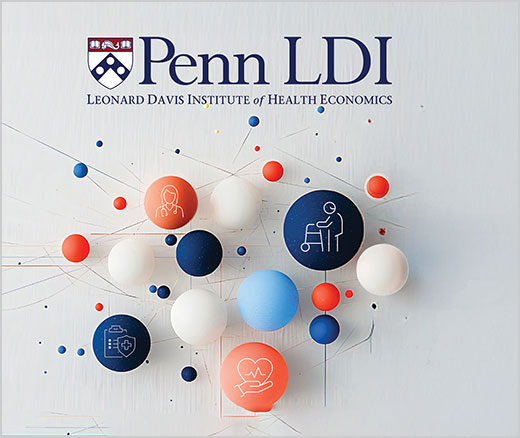
In the Loop or On the Loop: The Conundrum of AI Clinical Decision Support
2025 Penn Nudges in Health Care Symposium Focuses on the Human-Machine Interface
News
Since the Food and Drug Administration first (FDA) began approving commercial applications of CAR-T and CRISPR cell and gene-based therapies (CGT) over the last six years, there has been a growing national debate about how to make these therapies available to the people who need them. There are several barriers to achieving that goal, but the most formidable one is the astronomical cost. Pharmaceutical corporations price these therapies in the millions of dollars for a single treatment. Earlier this year, market analysts reported there are now approximately 32 approved gene therapies currently on the market globally and that that number will continue to rise along with the novel funding quandaries they present.
On September 13 the University of Pennsylvania’s Leonard Davis Institute of Health Economics (LDI) convened a panel of four top experts to explore the economic, access, and equity issues raised by the cost of treatments that pose such a challenge to commercial, public, and employer insurers; as well as to large numbers of patients suffering previously incurable diseases that can now be cured—for a price beyond reach.

The panel members were Stacie Dusetzina, PhD, a Professor of Cancer Research at Vanderbilt University and current Commissioner on the Medicare Payment Advisory Commission (MedPAC); Titilope Fasipe, MD, PhD, Assistant Professor and Co-Director of the Sickle Cell Program at Baylor College of Medicine; Jarrod Henshaw, JD, former Chief Executive Officer of Synergie Medication Collective; and Aaron Kesselheim, MD, PhD, who leads Harvard University’s Interdisciplinary Program on Regulation, Therapeutics and Law (PORTAL).
“It’s not the first time the United States is experiencing the arrival of a high-cost breakthrough medical therapy,” said panel moderator and LDI Director of Policy David Grande, MD, MPA, as he opened the session. “We had similar debates when hepatitis C therapy costing tens of thousands of dollars arrived. However, the cost of the current gene therapy breakthroughs has risen into the millions of dollars and raises some really important policy questions.”

“From an economics perspective, there are a couple of key problems in our system that have made these therapies hard to access for patients and hard to manage for payers,” said panelist Dusetzina. “One is the pricing models. CAR-T is a good example of one of the first cell therapies available. And the pricing for that back then was $373,000 for an adult. When that first came out, there were a lot of concerns about access because of the way that Medicare payment was set up for CAR-T—in some cases it would not be enough to cover the amount that a hospital would spend while delivering the therapy. In addition, on the commercial market and for the Veterans Administration (VA) and for other payers, there were different single case agreements being negotiated with hospitals to define who could get access and who could get an agreed upon payment.”
“There has been progress on getting access, but the prices have also gone up dramatically since that time,” Dusetzina continued. “We’re talking about products entering the market at $2, $3, $4 million dollars per patient. And that creates additional stressors. One thing I think is important for understanding the context of the challenge is the fragmentation of our payer system. The earlier therapies were predominantly covered by Medicare, but we now have a lot of products for people covered by Medicaid and those state programs don’t have flexibility in their budgets to be able to overrun their spending targets for the year.”
[In the last several months, the Centers for Medicare & Medicaid Services (CMS) has begun inviting states to participate in its new Cell and Gene Therapy Access Model. That program plans to negotiate “outcomes-based agreements” for lower prices and broad access with the major cell and gene-based pharmaceutical product companies.]
Moderator Grande asked Dusetzina if there needs to be a Medicare Part E in which the public sector assumes the entire role related to these types of therapies.
“I am a big fan of thinking about really disrupting the way we pay for these types of therapies,” Dusetzina responded. “Who’s getting them now? People who are the wealthier individuals in our country who are on commercial health plans. I think the way we’ve set things up to date will drive more inequity. The fragmentation of payers is a critical problem, and we need as much size as possible for negotiations. So, if you had a single payer for cell and gene therapy that decided what the right payment was, we could get maybe better access for pharmaceutical companies to know that once they agreed on a price, they had an entire patient population that could receive it. And it wouldn’t be these single case agreements. I think we have to throw out the current model if we’re going to make these therapies really accessible to all people in our country.”

Perhaps the starkest equity contrast in the discussion was related to the therapies for sickle cell disease, a condition that overwhelmingly impacts Black Americans, a community that, along with Hispanic individuals, has the highest level of poverty of any racial or ethnic group. Current reported prices for the two currently available sickle cell gene treatments range from $2.2 million to $3.1 million per patient.
Baylor Sickle Cell Program Co-Director Fasipe pointed out that much of the media attention and public debate over gene-therapy prices has focused on drug company pricing without mentioning the large amounts of time and additional financial resources patients require to just get through the complex sickle cell treatments that take six to 12 months to complete.
“To understand the full, non-obvious cost in money and time of a treatment, you have to focus on what it looks like to be a patient,” said Fasipe. “Gene therapy for sickle cell is a transplant-based therapy. [The patient’s blood-related stem cells are extracted and modified outside the body and later transplanted back into the body.] Because it is a transplant-based therapy, the same health care utilization associated with transplants overlaps into the sickle cell space. So, from the beginning to the end of the process, the patient is dealing with a hematologist as well as a transplant doctor.”
“If everything goes well during the several months of their pre-transplant screening and processing, the cells are collected. Then there is a period of time to process and manufacture the cells. When it is time to deliver the therapy, the patient is admitted to a hospital facility where the cells are transplanted. They stay in the facility for one to two months if there are no complications. Once they are out of the hospital, there are frequent return visits to make sure all is well within the new cells. So, I tell patient families they’ll be pausing their lives for one to two years to get this therapy.”
Fasipe emphasized that much of the administrative and personal costs and time taken up by this experience are in addition to the multimillion dollar cost paid to the pharmaceutical companies. Those additional costs are often beyond what many commercial, public, and employer insurers are willing to cover. This issue is further exacerbated by the limited number of hospital centers qualified to perform these gene therapies across the country. Patients are often required to travel to another state to reach one and must then reside in that location for months. That brings up other issues including the cost of temporary living facilities, patient and family members’ missed work, missed school, and other serious life disruptions.
“It’s been almost two years since the FDA approved the two sickle cell treatments and we are just now evaluating children to get the treatment—and those children who do, have a commercial payer,” Fasipe said. “For patients who are Medicaid beneficiaries, we were excited to hear about the CMS innovation model, but that means we will have to wait until we can understand what our state’s Medicaid program will actually do.”
“In many discussions like this one, the focus tends to be on, ‘It costs $4 million. Let’s figure out how to pay for that,'” said Harvard’s Kesselheim. “But I think the thing we should be thinking about is ‘should it really cost $4 million in the first place?'”
“In the United States we don’t have a system for coming up with what the price of a treatment or product in the pharmaceutical space should be,” Kesselheim said. “We let drug companies set whatever price they think they can get away with. As a result, the prices of brand drugs and treatments here are two to three times higher than they are in other high-income countries. In a lot of cases these innovative treatments originate in publicly funded projects where the National Institutes of Health (NIH) uses taxpayer funds to support their development through a lot of the riskiest early-stage phases and drug companies come into this process relatively late.”
“If there is a product that needs a high price because that’s what it takes to make it work, then we should figure out how to make that available to patients. But before we get there we should be stepping back and asking ourselves, ‘What is a fair price and how do we get there?’,” said Kesselheim.
Henshaw, retired CEO of the Synergie Medication Collective, has a unique perspective on the issue. Synergie is a two-year-old stand-alone contracting model focused on high-cost therapy coverage for the combined 100 million customers of Blue Cross and Blue Shield-affiliated companies. “One of the first things that we wanted to really focus on was cell and gene therapies because it’s an area that the payer system is not currently equipped to deal with, both short-term and long-term,” Henshaw said.
“Our first solution set really dealt with the manufacturer and the notion of what is fair value?” said Henshaw. “This concept of paying millions of dollars upfront for a therapy with the promise of either curative or durability results—is that fair? What should the obligation of the manufacturer be if the drug doesn’t work right? If the drug doesn’t work, in my opinion, the manufacturer should be on the hook for some or all of that. I think today’s value-based care contracts are worthless in their promise and commitment to refund money when a drug doesn’t work. So, we wanted to create a portfolio for the first time that creates that construct that is equitable for the payers and for manufacturers.”
“Our second solution was the concept of thinking about how to actually finance these types of therapies. If you’re a small, self-funded employer and you unexpectedly get hit with one of these price tags in today’s market, most types of insurance really don’t cover a lot of these therapies. That can be catastrophic for an employer. So, we created what we call a national risk pool across the 100 million customers to spread that risk and allow small self-funded employers to be able to pay a very small amount to participate in this fund. If they happen to have a cell or gene therapy, then the risk pool bears the expense of that. And that’s been very effective. And by the way, that’s the largest risk pool in the United States to date.”
“The third problem we were going after is the national issue of where you get the best care. For various therapies there are certain centers that are qualified, but not every state has qualified centers. So, thinking about how to connect that patient across the United States to the best care center and importantly, at a fair and reasonable price, because it’s not only the drug therapy that’s being reimbursed, but all of the administrative costs, which are quite expensive.”
As the session ended, Grande asked the panelists for a final comment identifying one piece of advice they could give to policymakers to improve affordability and access for cell and gene therapies? Their answers:
Fasipe: “Continue to put the lived experience of the patient and the family into your conversations and decisions.
Henshaw: “Get away from fragmentation and go more toward a uniform approach, coalescing data and spreading risk.”
Kesselheim: “Expand current CMS negotiation to encompass cell and gene therapies so that we can have a real conversation about what these things should actually cost.
Dusetzina: “Medicare Part CGT (as in Cell and Gene Therapy).”


2025 Penn Nudges in Health Care Symposium Focuses on the Human-Machine Interface

Former Philadelphia Health Commissioner Warns That Gutting the CDC, Undermining Vaccines, and Politicizing Science Will Leave the U.S. Dangerously Unprepared for the Next Pandemic

Some Hospice Agencies Adjusted Admissions and Discharges to Maximize Payments

New Program Launches Research Initiatives Focused on Improving Primary Care for Older Adults

Rural Parents Had More Emergency Visits and Insurance Loss Than Urban Peers, an LDI Study Shows. Integrated Baby Visits Could Help All Parents Be Healthier

Penn and Four Other Partners Focus on the Health Economics of Substance Use Disorder